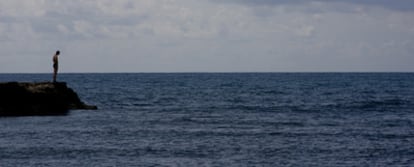The mild Med of Murcia
You'll find the warmest waters washing up on the coves along Lorca's coast
The municipality of Lorca, Murcia has nearly eight kilometers of coastline, nearly all of which falls within the bounds of the Regional Park of Cabo Cope y Puntas de Calnegre.
This little piece of heaven is now closer thanks to the AP-7 turnpike. The mountainous landscape between the capes of Tiñoso and Cope is strongly influenced by its desert-like climate and features no trees, but rather sparse vegetation that has adapted to the dry Murcian climate.
This rosary of pristine coves has been declared a site of European interest because it is home to the spur-thighed tortoise, a vulnerable species, as well as the peregrine falcon and the trumpeter finch, a common bird species in Africa whose presence in Murcia is a bioindicator of climate change.
To get there by car, drive to Ramonete and then head out toward the sea for around six kilometers, until you reach a sign for Calas de Lorca.
A kilometer and a half from here is Puntas de Calnegre, a place where visitors would do well to stop at the local bar-cum-grocery store, simply called Mercedes. Inside, Mercedes, her sister and her son serve up paellas and other typically Murcian dishes. Nearby, the old Civil Guard headquarters has been transformed into a hostel located not 50 meters from the beach.
Back by the Calas de Lorca sign, a dirt track leads straight to arresting views of the cliffs. These are made from a combination of slate and quartzite, which lends them the blackish air suggested by the name Calnegre.
As if all this were not enough, the water temperature around here is five degrees warmer than elsewhere along the Mediterranean coast: the cold currents that enter through the Strait of Gibraltar barely touch the Gulf of Mazarrón, and move on without affecting it.
Although the cove of Calnegre provides a uniquely solitary sight, Cape Cope is even more impressive. This is where you will find the most popular beach in the area (expect traffic jams after 10.30am), although it is also the most dangerous when the sea is rough, because of treacherous underwater currents.
Besides golden sand, it has restrooms, handrails and the only chiringuito (drinks and food bar) in the whole of Calnegre.
The next cove in a southern direction is Baño de las Mujeres, a protected enclave of reduced dimensions and a place of preference for those who would rather do without the easterly wind that blows elsewhere.
Along the way to the next stop, Siscal cove, you will come across a strip of gravel that was once an anchorage point for vessels between Puntas de Calnegre and Cape Cope.
At the back of the beach, a sign directs your attention to the sea daffodils, a very showy plant species that is currently in bloom.

Tu suscripción se está usando en otro dispositivo
¿Quieres añadir otro usuario a tu suscripción?
Si continúas leyendo en este dispositivo, no se podrá leer en el otro.
FlechaTu suscripción se está usando en otro dispositivo y solo puedes acceder a EL PAÍS desde un dispositivo a la vez.
Si quieres compartir tu cuenta, cambia tu suscripción a la modalidad Premium, así podrás añadir otro usuario. Cada uno accederá con su propia cuenta de email, lo que os permitirá personalizar vuestra experiencia en EL PAÍS.
¿Tienes una suscripción de empresa? Accede aquí para contratar más cuentas.
En el caso de no saber quién está usando tu cuenta, te recomendamos cambiar tu contraseña aquí.
Si decides continuar compartiendo tu cuenta, este mensaje se mostrará en tu dispositivo y en el de la otra persona que está usando tu cuenta de forma indefinida, afectando a tu experiencia de lectura. Puedes consultar aquí los términos y condiciones de la suscripción digital.
Últimas noticias
Most viewed
- Why we lost the habit of sleeping in two segments and how that changed our sense of time
- Trump’s obsession with putting his name on everything is unprecedented in the United States
- Pablo Escobar’s hippos: A serious environmental problem, 40 years on
- The Florida Keys tourist paradise is besieged by immigration agents: ‘We’ve never seen anything like this’
- Charles Dubouloz, mountaineering star, retires at 36 with a farewell tour inspired by Walter Bonatti








































